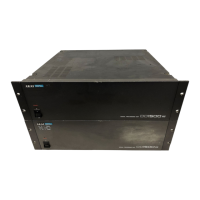UTILITIES - RS422 - MASTER - 18
Version 2.00 - March, 1996 Page 163
EXT M/C SYSTEM
USER KEYS MACRO
MIXER DSP
SAVE DIRECTORY
SHIFT
AUTO REHEARSE
CYCLE PRE-ROLL
EXT. TIME
GRAB TIME
GOTO
EXIT UNDO EXECUTE
COPY CUT ERASE PASTE INSERT TRIM
EDIT CUE IN OUTSYNC SELECT CUE
CURSOR
JOG
SPOOL
NUDGE DATA ENTRY/NUDGE
ENABLE
LEVEL
PAN LINE OUT
HEADPHONE
LEVEL
OUT A
OUT B
SET
SET
SET
SET
SET
SET SET
SHOW
MACRO REC
OFFSET
REVERSE
> CUT DISCARD IN > NOW
REDO
STORE
JOG/SPOOL
ZOOM OUT ZOOM IN
TRACK ZOOM
F1 F2 F3 F4 F5 F6
L R MIN MAX
MI MAX
UTILITIES EDITAUTOLOCATOR NUMERIC ENTRY
PLAYSHEET
+12dB
0dB
PLAY
123
456
789
0
CLR
-/< +/>
00
FRO
LAST TO
OVER
IN
OUT
FROM
REC
LOAD
DD1500 AS AN RS422 MASTER
The DD1500 can be used as an RS422 master using the Sony™ P2 protocol. This means
that all play, jog, shuttle and locate commands are issued from the DD1500 allowing you
to control a VTR equipped with RS422 and the DD1500 together. Connections should be
made as shown in the CONNECTIONS section with the DD1500m’s RS422 output
connected to the VTR and the timecode output from the VTR connected to the
DD1500m’s timecode input.
Switching on the EXT M/C key engages the RS422 function. Because it is necessary for
the external VTR to ‘report back’ its timecode position to the DD1500 via the SMPTE IN
and EXT. TIME key, when you switch EXT M/C on, the EXT. TIME key automatically
switches on to ensure correct lock up of both the DD1500 and the VTR.
However, because of the frame accuracy limit imposed on the DD1500 by the VTR over
RS422, it is sometimes necessary to ‘isolate’ the DD1500 for greater editing accuracy, To
do this, simply switch off EXT M/C and EXT. TIME - this will allow the DD1500 to be used
‘stand alone’.
As a practical example, let’s say you are trying to sync a door slam sound effect in the
DD’s project with the picture on video. You could, of course, do everything referenced to
frame accurate picture but, you just cannot get the door slam precisely in sync. By
switching off EXT M/C and EXT. TIME, you can momentarily disengage the VTR,
‘isolating’ the DD1500 and you can place the sound effect, nudging it backwards or
forwards in sub-frame increments on the DD1500 until you think it’s at the right position.
You can then re-engage the VTR by switching on EXT M/C and EXT. TIME again and
trying it out against picture. You can repeat this process until it’s perfectly in sync.
For those few occasions where it may be necessary to control
only
the VTR, it is also
possible to disengage the DD1500 by only switching off the EXT. TIME key when the EXT
M/C key is on. In this case, the DD1500 is effectively disabled and you can control just the
VTR from the DL1500.

